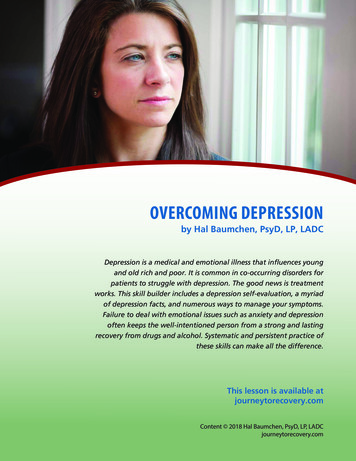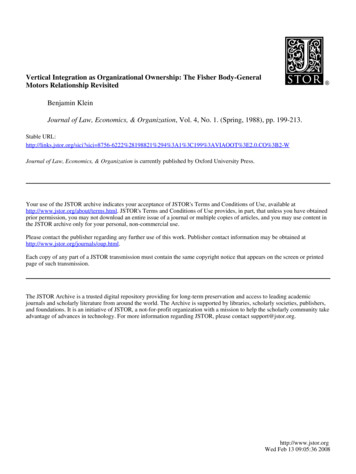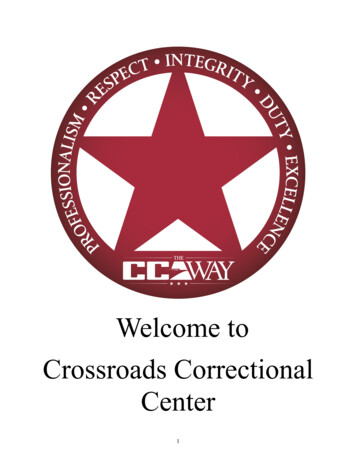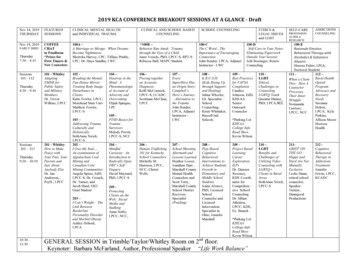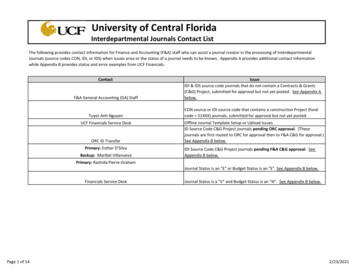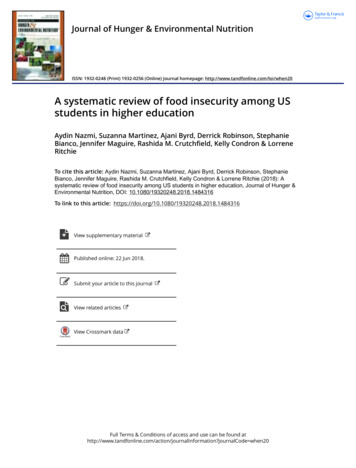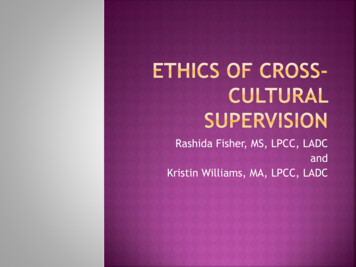
Transcription
Rashida Fisher, MS, LPCC, LADCandKristin Williams, MA, LPCC, LADC
RashidaFisher Kristin Williams MARRCH Ethics Committee
Identify,review, and apply the ethicalconsiderations of multicultural counselingcompetencies Learn how to intentionally acknowledge andaddress cross-cultural challenges within thesupervisory relationship Explore how your cultural lens influencesyour supervisory approach
One of the most effective ways for acquiring culturalcompetence is positive supervision experiences thatuphold and cultivate cultural expertise (Sue & Sue, 2008)Multicultural competence is one of the core areas inclinical supervision (Falender & Shafranske, 2014).Supervisees often encounter supervisors who lacksome of these competencies (Berger, Conroy,Peerson,&Brazil,2014). Many supervisors are found to lack sensitivity tocultural issues with both their supervisees and theirclients (Berger, Conroy, Peerson,& Brazil,2014).Supervisors who were uncomfortable or ill-equippedto address multicultural issues ignored or minimizedthe supervisee’s value and uniqueness resulting in anegative supervision experience (Constantine & Sue, 2007; Inman& Ladany,2014).
1.2.3.4.What do you most identify with/think mostabout?What do you think about least?What do you value or think is most important?What has the strongest impact on how you viewyourself?
(1)implements goals consistent with the lifeexperiences and cultural values of clientsand acknowledges multiple client identities(e.g. individual, group, and universal) (2) uses universal and culture-specificstrategies and roles in the healing processwhile balancing the salience of individualismand collectivism in assessment, diagnosis,and treatment interventions of clients andclient systems.(Sue & Torino, 2005)
supervisors should be able to: Facilitate their own awareness of personal values,biases, and worldview. Facilitate supervisees’ awareness of personal values andbeliefs. Facilitate multicultural client conceptualizations; Guide supervisees towards utilizing culturallyappropriate interventions with clients. Attend to multicultural processes in supervision And Effectively evaluate supervisees’ multiculturalcompetencies.(Ancis & Ladany, 2010)
Developed by a 5-member committee appointed by thepresident of the Association for MulticulturalCounseling and Development. Endorsed in June 2015 by the executive council of theAMCD and in July 2015 by the ACA governing council. Replaces (revises) the 1992 Sue, Arredondo, andMcDavis Multicultural Counseling Competencies, whichfocused on "majority" counselors working with"minority" clients.
4 quadrants Privileged Counselor and Marginalized Client Privileged Counselor and Privileged Client Marginalized Counselor and Privileged Client Marginalized Counselor and MarginalizedClient Supervisor– where does this fit?
Thesupervision encounter occurs between thesupervisor’s, the therapist’s, and the client’stheoretical and personal and cultural maps.Supervisor’sMapCounselor’sMapClient’s Map(Falicov, 2014)
Counselor ClientSelf-AwarenessWorldview CounselingRelationship Interventions(Counseling and Advocacy)
First 3 domains:Attitudes and Beliefs (Awareness and Acknowledgement) Knowledge Skills Actions Fourth Domain (Intervention): Incorporates Socioecological Model as framework for counselingand advocacy at different levels (helps understand need forindividual or system-wide interventions)
Whatis your definition?
Culture Complex and richDefined by a community or societyStructures the way people view the worldInvolves particular beliefs, norms, and valuesconcerning relationships, the way people livetheir lives, and how people organize theirenvironments Culture isis NOTA definable entity to which people belong ordon’t belong Peoplebelong to multiple cultural groupsTIP 59
1.Counselor Development 2. Professional & Ethical Standards 3. Program Development & Quality Assurance 4. Performance Evaluation 5. Administration 6. Treatment KnowledgeMinnesota Certification Board
“Complex process that involves teaching,facilitating, collaborating, and supportingcounselor self-efficacy supervisors also mustconsistently maintain a multiculturalperspective” (TAP 21A, p.30). Encourage supervises to examine their viewsregarding culture, race, values, religion, gender,sexual orientation, and potential biases Help supervisees recognize, understand, andcope with unique problems of transference andcountertransference when working with clientswith SUDs TAP 21-A
Refersto the protection of the public,clients, and staff members and thedevelopment of supervisors’ professionalidentity and integrity Learn about supervisee’s’ cultures, lifestyles,beliefs, and other key factors that mayinfluence their job performance Monitor supervisees’ clinical practice toenhance their competence and ensure theirethical treatment of clientsTAP 21-A
Maximize the potential of staff and resources tomeet the needs of the clientele and ensureeffectiveness and efficiency of servicesP Provide diversity training and other experiencesthat empower one to become an advocate forthe organization’s target population and anagent of organizational change Structure and facilitate staff learning aboutevidence-based treatment interventions,program service design, and recovery modelsrelevant to the organization and the populationit serves TAP 21-A
Regularlymonitor the quality ofperformance, facilitate improvement inclinical competence, and assess readiness topractice with increasing autonomy. Assess professional development, culturalcompetence, and proficiency in addictioncounseling competencies Understand the concept of supervision as atwo-way evaluative process with each partyproviding feedback to the otherTAP 21-A
Followingpolicies and procedures, ensuringmaintenance of case records, monitoringcase documentation, assisting in financialresource development, and developingrelationship with referral sources in thecommunity Obtain regularly scheduled diversity, crisismanagement, and safety training for oneselfand superviseesTAP 21-A
“Haveprofessional experience with andknowledge of the field of addictions, socialand behavioral science and self-helpphilosophy” “Understand the limitations of andappropriateness of assessment andevaluation tools utilized in the addictionfield”Minnesota Certification Board
Whatare some examples of cross-culturalchallenges that you have experienced eitheras a supervisee or a supervisor?
Supervision is a distinct intervention that is separatefrom, but overlaps with, teaching, psychotherapy,and consultation (Watkins, 2010).Ability to navigate smoothly among the differing rolesand functions of supervision (Wallace, Wilcoxon,& Satcher, 2010).The supervisor and supervisee join together topromote the development of the supervisee andprotect clients’ well-being (Haynes, Corey, & Moulton, 2013).Includes both task and person-centered behaviors(Wong, Wong, & Ishiyama, 2013).Positive supervisor-Supervisee relationship thatembodies warmth, acceptance, respect,understanding, and trust (Wong, Wong, & Ishiyama, 2013).Outcome Promotes supervisee growth &development and ensures quality client care
Ineffective Supervision Lack of empathy and support, Failure to consistently track supervisees concerns, Lack of teaching or instruction, Indirectness and intolerance, closed mindedness,lack of respect for differences, Sexism, Inappropriateness, intolerance, apathy, and, Poor modeling of professional and personal attributes Outcome Does not promote or may inhibit growthof supervisee, neutral implications for client care.(Wong, Wong, & Ishiyama, 2013)
Harmful Supervision- defined supervision as thatwhich impairs or traumatizes the supervisee. Abuse of power and authorityFailure to attend to multicultural differences andrelated issues between supervisors and superviseesTransference/ counter transferenceImposition of the supervisor's personal belief system onthe superviseeGender-role and other stereotyping.Outcome Prohibits growth and creates psychologicaldistress of supervisee, Negatively impacts client care.(McCleod, 2009; Wong, Wong, & Ishiyama, 2013)
Students/ Supervisees identified effectivesupervision(a) competence—general levels of knowledge,(b) competence—facilitation of learning,(c) relationship factors, and(d) effectiveness of evaluation. Supervisors identified effective supervision(a) students’ development,(b) relationship factors,(c) ethics, and(d) adaptability.
CriticalRace Dialogue: discussions that touchupon issues of race, racism, whiteness, andwhite privilege Understanding one’s Racial/ cultural identityAcknowledging and being open to admitting biasesComfort with discussing issues of race, racism,power, and privilegeValidate and facilitate discussions of feelings,emotions, affective experiencesControl the process, not the content.(Sue, 2015)
Critical Race Dialogue: Violates social norms Clashes in racial realities Conflict leads to defending one’s position rather than andexchange of ideas, White narrative Vs. Counter narrativePushes emotional hot buttons Politeness protocolAcademic protocolColor-blind protocolAnger, resentment, fear, inadequacy, exhaustion, guilt.pessimism, helplessness invalidation, defensivenessEvokes avoidance strategies The discomfort leads to attempts to dilute, diminish,change, mystify the topic.(Sue, 2015)
Counselor Supervisor
Non-discrimination Responsibility Competence Legaland Moral Standards Public Statements Publication Credito Interprofessional Client welfareRelationships Confidentialityo Remuneration Client Relationships o Societal ObligationsMCB, 2015
Counseling Relationship Confidentiality and Privileged Communication Professional Responsibilities and WorkplaceStandards Working in a Culturally Diverse World Assessment, Evaluation and Interpretation E-therapy, E-supervision, and social media Supervision and consultation Resolving Ethical Concerns Research and Publication NAADAC, 2016
Supervision Ruleson Conduct Competence Client Welfare and Rights Professional Behavior Supervisory RoleMinnesota Certification Board, 2015
Kristin Williams, MA, LPCC, LADCKristin.williams@alfredadler.edu612-767-7057 Rashida Fisher, MS, LPCC, LADCRashida.fisher@alfredadler.edu612-767-7062
Center for Substance Abuse Treatment. Clinical Supervision and ProfessionalDevelopment of the Substance Abuse Counselor. Treatment ImprovementProtocol (TIP) Series 52. DHHS Publication NO. (SMA) 09-4435. Rockville, MD:Substance Abuse and Mental Health Services Administration, 2009.Center for Substance Abuse Treatment. Competencies for Substance AbuseTreatment Clinical Supervisors. Technical Assistance Publication (TAP) Series21-A. HHS Publication No. (SMA) 13-4243. Rockville, MD: Substance Abuseand Mental Health Services Administration, 2007.Center for Substance Abuse Treatment. Improving Cultural Competence.Treatment Improvement Protocol (TIP) Series 59. HHS Publication NO. (SMA)15-4849. Rockville, MD: Substance Abuse and Mental Health ServicesAdministration, 2014.Berger, G., Conroy, S., Peerson, A., & Brazil, V. (2014). Clinical supervisorsand cultural competence. The clinical teacher, 11(5), 370-374.Haynes, R., Corey, G., & Moulton, P. (2003). Clinical Supervision in thehelping professions: A practical guide. Pacific Grove, CA: Brookes/ColeInman, A. G., & Ladany, N. (2014). Multicultural competencies inpsychotherapy supervision. In F.T.L.Leong (Ed) APA Handbook onMulticultural Psycholog, 2(1), 643-658.
Minnesota Certification Board. Certified Clinical Supervisor Reciprocal. 2015.Minnesota Certification Board. Code of Ethical Conduct for Alcohol and DrugCounselors. 2015.NAADAC, the Association for Addiction Professionals. The NationalCertification Commission for Addiction Professionals Code of Ethics. 2016.Sue, D.W. (2015). Race talk and the controversy of silence: Understandingand facilitating difficult dialogues on race. Hoboken, NY: John Wiley & Sons.Wallace, M., Wilcoxon, S., & Satcher, J. (2010). Productive andnonproductive counselor supervision: Best and worst experiences ofsupervisees. Alabama Counseling Association Journal, 35(2), 4-13.Watkins, C. E. (2010). Psychotherapy supervision since 1909: Some friendlyobservations about its first century. Journal of Contemporary Psychotherapy,41, 57–67.Wong, L. C. J., Wong, P. T. P., & Ishiyama, F. I. (2013). What helps and whathinders in cross-cultural clinical supervision: A critical incident study. TheCounseling Psychologist,41(1), 66-85.
Competencies for Substance Abuse Treatment Clinical Supervisors. Technical Assistance Publication (TAP) Series 21-A. HHS Publication No. (SMA) 13-4243. Rockville, MD: Substance Abuse and Mental Health Services Administration, 2007. Center for Substance Abuse Treatment. Improving Cultural Competence. Treatment Improvement Protocol (TIP) Series 59.


